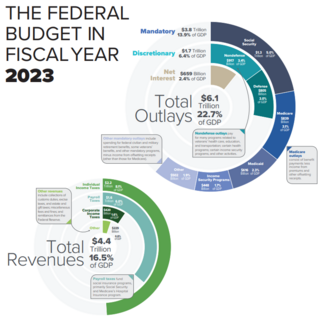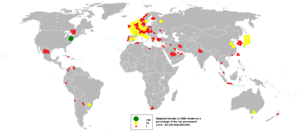
In economics and political science, fiscal policy is the use of government revenue collection and expenditure to influence a country's economy. The use of government revenue expenditures to influence macroeconomic variables developed in reaction to the Great Depression of the 1930s, when the previous laissez-faire approach to economic management became unworkable. Fiscal policy is based on the theories of the British economist John Maynard Keynes, whose Keynesian economics theorised that government changes in the levels of taxation and government spending influence aggregate demand and the level of economic activity. Fiscal and monetary policy are the key strategies used by a country's government and central bank to advance its economic objectives. The combination of these policies enables these authorities to target inflation and to increase employment. In modern economies, inflation is conventionally considered "healthy" in the range of 2%–3%. Additionally, it is designed to try to keep GDP growth at 2%–3% percent and the unemployment rate near the natural unemployment rate of 4%–5%. This implies that fiscal policy is used to stabilise the economy over the course of the business cycle.

Within the budgetary process, deficit spending is the amount by which spending exceeds revenue over a particular period of time, also called simply deficit, or budget deficit: the opposite of budget surplus. The term may be applied to the budget of a government, private company, or individual. Government deficit spending was first identified as a necessary economic tool by John Maynard Keynes in the wake of the Great Depression. It is a central point of controversy in economics, as discussed below.

Public finance is the study of the role of the government in the economy. It is the branch of economics that assesses the government revenue and government expenditure of the public authorities and the adjustment of one or the other to achieve desirable effects and avoid undesirable ones. The purview of public finance is considered to be threefold, consisting of governmental effects on:
- The efficient allocation of available resources;
- The distribution of income among citizens; and
- The stability of the economy.

The government budget balance, also referred to as the general government balance, public budget balance, or public fiscal balance, is the difference between government revenues and spending. For a government that uses accrual accounting the budget balance is calculated using only spending on current operations, with expenditure on new capital assets excluded. A positive balance is called a government budget surplus, and a negative balance is a government budget deficit. A government budget presents the government's proposed revenues and spending for a financial year.

Government spending or expenditure includes all government consumption, investment, and transfer payments. In national income accounting, the acquisition by governments of goods and services for current use, to directly satisfy the individual or collective needs of the community, is classed as government final consumption expenditure. Government acquisition of goods and services intended to create future benefits, such as infrastructure investment or research spending, is classed as government investment. These two types of government spending, on final consumption and on gross capital formation, together constitute one of the major components of gross domestic product.

Monetary policy pertains to the regulation, availability, and cost of credit, while Fiscal policy deals with government expenditures, taxes, and debt. Through management of these areas, the Ministry of Finance regulated the allocation of resources in the economy, affected the distribution of income and wealth among the citizenry, stabilized the level of economic activities, and promoted economic growth and welfare.

A fiscal adjustment is a reduction in the government primary budget deficit, and it can result from a reduction in government expenditures, an increase in tax revenues, or both simultaneously.

Fiscal policy is any changes the government makes to the national budget to influence a nation's economy. "An essential purpose of this Financial Report is to help American citizens understand the current fiscal policy and the importance and magnitude of policy reforms essential to make it sustainable. A sustainable fiscal policy is explained as the debt held by the public to Gross Domestic Product which is either stable or declining over the long term". The approach to economic policy in the United States was rather laissez-faire until the Great Depression. The government tried to stay away from economic matters as much as possible and hoped that a balanced budget would be maintained. Prior to the Great Depression, the economy did have economic downturns and some were quite severe. However, the economy tended to self-correct so the laissez faire approach to the economy tended to work.

The United States budget comprises the spending and revenues of the U.S. federal government. The budget is the financial representation of the priorities of the government, reflecting historical debates and competing economic philosophies. The government primarily spends on healthcare, retirement, and defense programs. The non-partisan Congressional Budget Office provides extensive analysis of the budget and its economic effects. CBO estimated in February 2024 that Federal debt held by the public is projected to rise from 99 percent of GDP in 2024 to 116 percent in 2034 and would continue to grow if current laws generally remained unchanged. Over that period, the growth of interest costs and mandatory spending outpaces the growth of revenues and the economy, driving up debt. Those factors persist beyond 2034, pushing federal debt higher still, to 172 percent of GDP in 2054.
Zero-based budgeting (ZBB) is a budgeting method that requires all expenses to be justified and approved in each new budget period, typically each year. It was developed by Peter Pyhrr in the 1970s. This budgeting method analyzes an organization's needs and costs by starting from a "zero base" at the beginning of every period. The intended outcome is to access the efficient use of resources by determining if services can be provided at a lower cost. However, the saving comes at the expense of a complete restructuring every budget cycle. Although used at least partially in both government and the private sector, there is some doubt whether ZBB has ever been utilized to its fullest extent in any organization.

The Ministry of Finance of Chile is the cabinet-level administrative office in charge of managing the financial affairs, fiscal policy, and capital markets of Chile; planning, directing, coordinating, executing, controlling and informing all financial policies formulated by the President of Chile.
In economics, a federal budget is the major plan for a federal government's estimated future revenues and spending for the coming fiscal year. The federal budget is representation of the financial plan for the goals and activities of the government which in turn reflects the debates surrounding the various economical principles and ideas. It is the main means of the redistribution of the national income and gross domestic product to meet the needs necessary in order for economic growth. Primarily, the government spends a significant amount of their financial resources in the areas of healthcare, the old and young and social security programs.
Public budgeting is a field of public administration and a discipline in the academic study of public administration. Budgeting is characterized by its approaches, functions, formation, and type.

The Budget of the State of Oklahoma is the governor's proposal to the Oklahoma Legislature which recommends funding levels to operate the state government for the next fiscal year, beginning July 1. Legislative decisions are governed by rules and legislation regarding the state budget process.
Political debates about the United States federal budget discusses some of the more significant U.S. budgetary debates of the 21st century. These include the causes of debt increases, the impact of tax cuts, specific events such as the United States fiscal cliff, the effectiveness of stimulus, and the impact of the Great Recession, among others. The article explains how to analyze the U.S. budget as well as the competing economic schools of thought that support the budgetary positions of the major parties.

Deficit reduction in the United States refers to taxation, spending, and economic policy debates and proposals designed to reduce the federal government budget deficit. Government agencies including the Government Accountability Office (GAO), Congressional Budget Office (CBO), the Office of Management and Budget (OMB), and the U.S. Treasury Department have reported that the federal government is facing a series of important long-run financing challenges, mainly driven by an aging population, rising healthcare costs per person, and rising interest payments on the national debt.

The Swiss federal budget refers to the annual revenue and expenditures of the Swiss Confederation. As budget expenditures are issued on a yearly basis by the government, the federal council, and have to be approved by the parliament, they reflect the country's Fiscal policy.

The federal budget of Russia is the leading element of the budget system of Russia. The federal budget is a major state financial plan for the fiscal year, which has the force of law after its approval by the Russian parliament and signed into law by the President of Russia. That the federal budget is the primary means of redistribution of national income and gross domestic product through it mobilized the financial resources necessary to regulate the country's economic development, social policy and the strengthening of the national defense. The share of federal budget accounts for a significant portion of the distribution process, which is the allocation of funds between sectors of the economy, manufacturing and industrial areas, regions of the country.
In Malaysia, federal budgets are presented annually by the Government of Malaysia to identify proposed government revenues and spending and forecast economic conditions for the upcoming year, and its fiscal policy for the forward years. The federal budget includes the government's estimates of revenue and spending and may outline new policy initiatives. Federal budgets are usually released in October, before the start of the fiscal year. All of the Malaysian states also present budgets. Since state finances are dependent on money from the federal government, these budgets are usually released after the federal one.

The 2023–24 Pakistan federal budget was the Federal Budget implemented by the government of Pakistan for the fiscal year 2023–24. The revised budget was presented to Parliament on 25 June, 2023 after Finance Minister Ishaq Dar introduced new taxes and expenditure cuts. The budget was accepted the next day. The Federal Budget entailed the raising of the Petroleum Development Levy (PDL) and lifting of all restrictions on imports. These revisions came after talks between the Prime Minister Shehbaz Sharif and IMF Director Kristalina Georgieva. The total budget outlay (expenditure) of the new budget was Rs14.46 trillion, 51% higher than the previous year. Federal Revenue for the budget was budgeted as Rs12.163 trillion, with Rs5.276 trillion being transferred to the provinces, leading to a net revenue of Rs6.887 trillion, 36.9% higher than the previous year. The FBR's budgetary target was set at Rs9.200 trillion, 23% than last year's target. The fiscal deficit being estimated at Rs6.923 trillion or 6.54% of the GDP. The budget claimed it added no new taxes, no increases in duties on import of essential items, exemptions of custom duties on certain agricultural goods, and an increase in government wages and minimum wage proposals. The budget included funding for a number of development initiatives to increase the nation's economic growth rate. The original outlays for the PDSP being estimated at Rs. 2.66 trillion for the development programme, which included a Rs. 950 billion federal Public Sector Development Programme (PSDP), that was approved by the Annual Plan Coordination Committee (APCC). The PDSP would later be further increased to Rs. 2,709 trillion, with Rs. 1,150 trillion being allocated to the Federal Portion, an increase of 58.2% from the previous budget of the development program. The government claimed to alleviate fiscal restrictions and boost sector growth, setting a GDP growth rate of 3.5 percent. This is despite claims of the government engaging in "poll politics", seen in the large Federal Development Budget. Ishaq Dar stated that “This budget should not be seen as an ‘election budget’ – it should be seen as a ‘responsible budget’" By the end of the financial year, Pakistan's real GDP growth rate was reduced to 0.3 percent.










